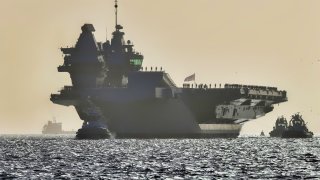CATOBAR vs. STOBAR: Which Aircraft Carrier Is Better?
The aircraft carrier is probably the most powerful weapon system in the world. A floating city with thousands of sailors and dozens of aircraft on board, aircraft carriers project power around the world like nothing else. But did you know that not all flattops are the same and there are two main types of carriers?
The aircraft carrier is probably the most powerful weapon system in the world. A floating city with thousands of sailors and dozens of aircraft on board, aircraft carriers project power around the world like nothing else.
But did you know that not all flattops are the same and there are two main types of carriers?
CATOBAR & STOBAR Aircraft Carriers
The two types of aircraft carriers are the Short Take-Off, Barrier Arrested Recovery (STOBAR) and Catapult Assisted Take-Off Barrier Arrested Recovery (CATOBAR).
Similar in many ways and yet different, both warships bring important capabilities to the battlefield.
STOBAR aircraft carriers are shorter and use a ski-jump—essentially a curved ramp at the fore of the ship—to assist fighter jets take off. STOBAR carriers require aircraft with a high thrust-to-weight ratio that can produce a lot of power to take off from a shorter runway.
They are also limited in how many and how fast they can launch aircraft.
Short take-off, vertical landing (STOVL) fighter jets like the F-35B Lighting II are ideal aircraft for STOBAR carriers because they don’t require much of a runway to take off or land. The two new aircraft carriers of the Royal Navy, the HMS Queen Elizabeth II and HMS Prince of Wales, combine a STOBAR system with F-35B Lighting II fighter jets.

On the other hand, CATOBAR aircraft carriers use a catapult to launch fighter jets. As such, they can deploy more aircraft at a faster rate than their smaller counterparts.
However, both flattops use arrested recovery to “catch” aircraft as they land.
The U.S. Navy fields 11 aircraft carriers, all of them CATOBARs.
STOBAR Carriers in Service
Although less capable overall than their CATOBAR siblings, STOBAR carriers continue to remain popular, mainly because they are cheaper and easier to build.
As of 2024, there are four STOBAR carriers in active service. The Chinese navy operates the Liaoning (Type 001) and Shandong (Type 002); the Indian navy operates the INS Vikramaditya and INS Vikrant. Out of these four warships, the Shandong and INS Vikramaditya were built in Russia and served in the Soviet Navy before getting sold to Beijing and New Delhi and getting refitted.

Some famous STOBAR aircraft carriers include the HMS Hermes and HMS Invincible, which led the British fleet in response to the Argentine invasion of the Falkland Islands in 1982. Paired with the Sea Harrier fighter jet, the two STOBAR carriers won air superiority over the battlefield and allowed the British military to recapture the Falklands.
But being cheaper, STOBAR carriers have some advantages over their larger counterparts. A smaller price tag allows for more risk in combat. For example, the USS Gerald R. Ford, the U.S. Navy’s newest carrier—a CATOBAR that can carry about 100 aircraft—has a price tag of around $13 billion. That immediately makes policymakers more hesitant to put it in harm's way. But a cheaper platform doesn’t carry as much risk and can be used much more aggressively in times of war.
About the Author
Stavros Atlamazoglou is a seasoned defense journalist specializing in special operations and a Hellenic Army veteran (national service with the 575th Marine Battalion and Army HQ). He holds a BA from Johns Hopkins University and an MA from the Johns Hopkins School of Advanced International Studies (SAIS). His work has been featured in Business Insider, Sandboxx, and SOFREP. Email the author: [email protected].
Main image is from Shutterstock. All others are Creative Commons.


